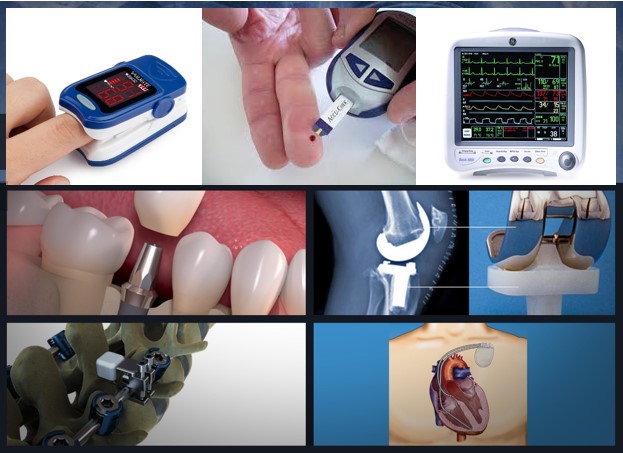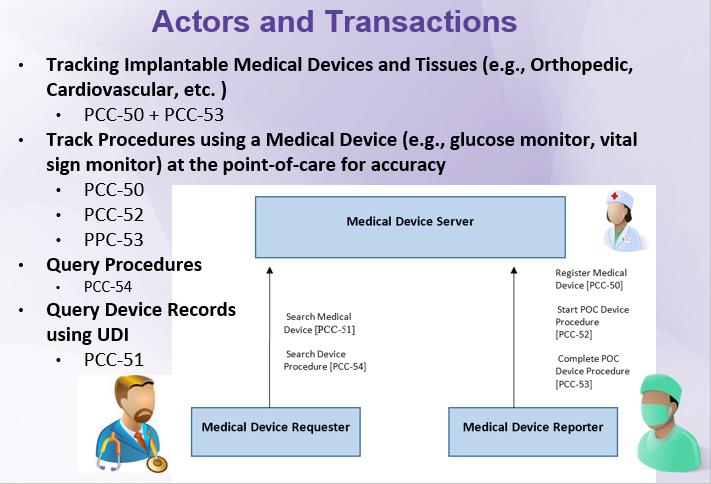Difference between revisions of "Point-of-Care Medical Device Tracking (PMDT)"
| Line 2: | Line 2: | ||
| − | ==Summary== | + | |
| + | == ==Summary == | ||
| + | == | ||
The Point-of-Care Medical Device Tracking (PMDT) Profile closes the loop on data acquisition at the point-of-care in support of reporting data about implantable medical devices (e.g., pacemaker, titanium plates) and medical devices (e.g., vital sign monitors, pulse oximeters, blood glucose monitors) during a procedure (e.g., Continuous Pulse Oximetry - 4A19XCZ, Insertion Pacemaker - 0JH607Z, Open Reduction Internal Fixation Elbow - 0PSJ04Z). The approach to acquiring the medical device information at the point-of-care enables it to be retrieved and reused at a later time. | The Point-of-Care Medical Device Tracking (PMDT) Profile closes the loop on data acquisition at the point-of-care in support of reporting data about implantable medical devices (e.g., pacemaker, titanium plates) and medical devices (e.g., vital sign monitors, pulse oximeters, blood glucose monitors) during a procedure (e.g., Continuous Pulse Oximetry - 4A19XCZ, Insertion Pacemaker - 0JH607Z, Open Reduction Internal Fixation Elbow - 0PSJ04Z). The approach to acquiring the medical device information at the point-of-care enables it to be retrieved and reused at a later time. | ||
| Line 9: | Line 11: | ||
| − | PMDTwikipageGeneral_Image.jpg | + | [[Image:PMDTwikipageGeneral_Image.jpg|450px]] |
==Benefits== | ==Benefits== | ||
Revision as of 13:51, 13 September 2017
==Summary
== The Point-of-Care Medical Device Tracking (PMDT) Profile closes the loop on data acquisition at the point-of-care in support of reporting data about implantable medical devices (e.g., pacemaker, titanium plates) and medical devices (e.g., vital sign monitors, pulse oximeters, blood glucose monitors) during a procedure (e.g., Continuous Pulse Oximetry - 4A19XCZ, Insertion Pacemaker - 0JH607Z, Open Reduction Internal Fixation Elbow - 0PSJ04Z). The approach to acquiring the medical device information at the point-of-care enables it to be retrieved and reused at a later time.
Benefits
The benefits of this profile are:
• Closes the loop on data acquisition at the point-of-care to support reporting of medical device data
o Medical device data can be exchanged with:
*Other providers for continuum of care (e.g., Discharge Summary, Referrals) *Registries (e.g., Total Joint Registry) *Payers for reimbursement (e.g., government provided, private insurance)
Associating a medical device used for monitoring a disease or symptom of a disease (e.g., vital sign monitors, pulse oximeters, blood glucose monitors) to a patient for:
Querying the device or procedure using the medical devices UDI Accurately matching the device data with the correct patient
• Increase patient safety o Traceability of medical devices (avoid use of counterfeit or illegitimate products) o Quality issues identified (e.g., recalls, adverse events)
• Increase accurate medical device data capture at the point-of-care o Eliminates human error from manual medical device data entry by using the devices unique device identifier (UDI) supplied in a structured format from the manufacturer o Provides a standards-based mechanism to capture medical device information consistently across the care setting
Details
Implantable medical devices are essential for the treatment and management of a wide variety of medical conditions. These devices are costly and concerns about illegitimate (i.e., counterfeit, stolen) products being used for patient care has become a global issue. Post-market surveillance of implantable medical devices can be challenging due to the longevity of the patient and the medical device unless there is a reliable implant tracking method. Using the HL7 FHIR StructureDefinition Resources (HL7 FHIR Device, HL7 FHIR Procedure Resource) to record information about medical devices (the unique device identifier [UDI]), including implantable/life-supporting/life-sustaining devices and tissues, provides a reliable and standards-based mechanism to perform a search and query function by using the HL7 FHIR RESTful Services (HTTP/HTTPS) to create/update and query existing records.
Systems Affected
- Enterprise EHRs
Actors & Transactions:
Specification
Profile Status: Trial Implementation
Documents:
<Provide direct links to the specific volumes or supplements, and list the volume sections relevant to this profile. This is a simple inventory of official normative and informative text. If you would like to provide a reading guide or walkthrough of what is in each of the different sections for implementers or users, do that in the Profile FAQ or the Profile Implementation Page linked below. If the profile uses transactions from multiple Tech. Frameworks, repeat the structure below.>
IHE Radiology Technical Framework:
Underlying Standards:
See Also
IHE PCD-01 transactions based on HL7 v2.7 ORU_R01
Related Profiles
- IHE PCC Remote Patient Monitoring (RPM) Profile

